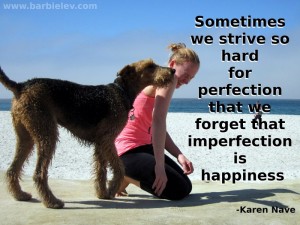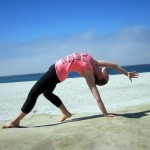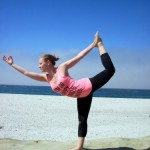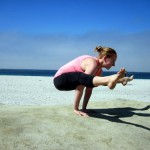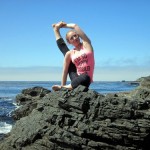Here’s an interesting hip-opening sequence you can take from downward facing dog. First, as you inhale, lift one of the legs upwards. This position builds strength in the lower back, glute (butt), and hamstring (back of the thigh) muscles. For some of you, it will be most appropriate for you to stay here to develop your strength and flexibility.
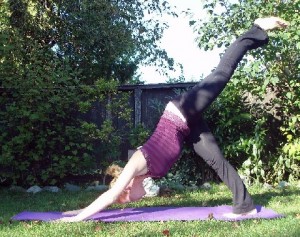
Three-legged downward facing dog.
If you can comfortably raise your leg above above the height of the hips, you can turn this into a hip-opener: on your next exhale, bend into the knee and let the heel relax across to the opposite side of the body. You should feel a stretch in the hip flexors (muscles in the front of the hip) of the lifted leg. Make sure you keep the abdominals contracted to protect the low back. This is a really nice hip opener if you have the flexibility to get here.
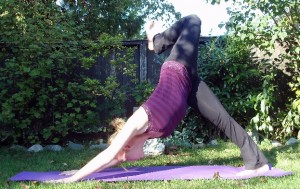
Bend into the knee and let the heel relax across to the opposite side of the body.
Some points of debate:
- some teachers say to keep the foot flexed, rather than just relaxing it. I’m not sure exactly what the justification is, but does seem to add integrity to the posture.
- As shown in the image above, I suggest you keep your chest squared to the floor (as much as possible), just like you would in downward facing dog; however, some teachers suggest you look out under the armpit (the one of the same side as the leg you’re lifting). Letting your torso twist in the direction allows you to get your leg farther across the body, which will allow gravity to do a little more work for you, and pull the leg into a deeper hip flexor stretch. The problem with this variation is it’s very easy to compromise the low back. If you do it this way, make sure you’re keeping the abdominals contracted and monitoring the low back.
If you know that you are comfortable with back bends, you can “flip the dog” into wild thing. But seriously, you have to be sure you can handle it, because there’s a point of no return in the transition–after that point you’ll continue all the way into wild thing, whether your body likes it or not. Staying in the previous posture is a really nice hip opener for those of you without an advanced back bending practice.
I don’t think there’s a better way to put this in words than by telling you to contract the abdominals, keep it under control, and “flip the dog” as you exhale.
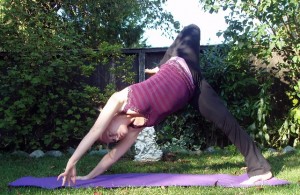
Beginning to flip the dog...
The foot of the bottom leg rotates so the toes point toward the back of the mat. As the belly turns skyward, the foot of the top leg continues down to the mat. The soles of the feet end up flat on the mat. The hand that lifts (the one on the same side as the lifted leg) is going to stay lifted and extend toward the front of the mat. You are now in wild thing. Does everything feel… groovy?
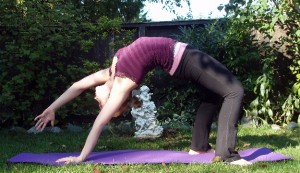
...ending up in wild thing.
In wild thing, make sure you keep the low back muscles contracted to support your pose. Keep the abdominals contracted to control the arch of the back. To explore your flexibility, think about contracting the quads (the muscles in the front of the thighs). This will begin to straighten the knees and raise the hips up higher.
To get out of wild thing, just follow the steps in reverse. Contract the abdominals and inhale as you flip back to downward facing dog.
